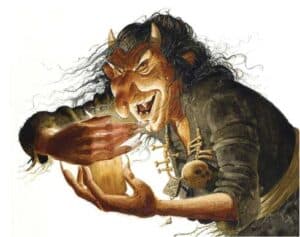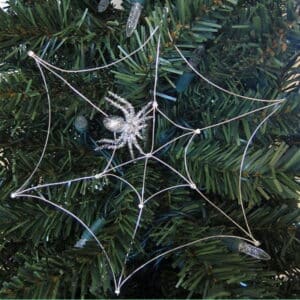Cyprus Mail 18 December 2022 - by Annette Chrysostomou
 |
| Mari Lwyd from Wales |
Christmas traditions: They can be heart-warming, motivating and downright scary
In some Cypriot mountain villages on Christmas night, it is customary to leave the doors of one’s house open, so the Virgin Mary and Christ can look into the house in form of wanderers, and be assured that everything in the house is ready for the holiday, i.e. the table is set and all the rooms are carefully tidied for the time when visitors will arrive.
This custom makes sense in a country where visitors are welcome, and is probably an additional motivation to give it your best if you haven’t already done so during the year. For younger generations, it may be an incentive to follow this custom.
But some traditions observed as part of the festive season are questionable at best, especially when they involve scaring small children.
Legend has it Cypriot goblins called Kallikantzaroi live beneath a tree connecting our world to the underworld. They spend their entire year beneath that tree, sawing their way into the outer world, and escape during the 12 days of Christmas, a period stretching from December 25 to January 6.

These evil small, dark creatures with animal parts – rat tails, donkey ears, monkey arms or boar tusks – come out during this period because Christ has not yet been baptised and cannot protect humanity from evil. Thus households lie unprotected, and this gives the goblins the chance to carry off babies not yet baptised. On the eve of epiphany, January 6 – the day Christ was baptised – they disappear until the next year.
Even more scary is Austria where a ghoulish creature called Krampus, the evil accomplice of St Nicholas (Father Christmas), is said to wander the streets in search of badly behaved children. During the month of December, one can expect to see terrifying masked figures out and about scaring kids and adults alike with ghastly pranks.
Kids in Wales who open the door on New Year’s Eve, expecting to let in guests, are bound to be terror-stricken when confronted with a creature with a horse’s skull, wearing a long, billowing cloak. In the horse’s eye cavities are fake eyeballs. Its mouth is slightly ajar. They have met Mari Lwyd.
In Iceland, Gryla is said to be a giant ogre who lives in a cave. During Christmas she emerges to hunt for children, who she kidnaps, takes to her cave, and cooks.
Worse, at least in the view of small kids who encounter her, Gryla has a number of companions, among them the Jólakötturinn, or Yule Cat.
The Yule Cat does not sit on your lap, purring contentedly, playing with the wrapping paper while you open your presents, and contributing to the overall atmosphere of a cosy Christmas. This is one cat which visits homes where children live, and by doing this it intends to catch children to eat instead of mice as part of its Christmas celebration.

However, this carrot-and-stick approach – taken to the extreme by the above-mentioned traditions – has now largely been discredited.
Up-to-date psychologists shudder at the thought of exposing children, especially the very young ones, to such experiences.
“I am totally against it,” Arlette Shohmelian, parent and mind-set coach based in Cyprus, said. “It is bad to inflict fear in children for any reason. Such fears translate into other fears and insecurities as the child cannot distinguish between what is rational and irrational. The message children get is ‘I am bad’, as they cannot reflect on certain types of behaviour which are judged by adults as good or bad, they rely on unconditional love while their nervous system is not fully developed. What is the purpose of scaring small children?”
Heart-warming traditions may make more sense.
Why do Ukrainians believe a spider net in a Christmas tree brings luck? The story goes that a poor widow and her children had a Christmas tree and no ornaments. The spiders in the hut decided they could not leave the tree bare and created beautiful webs on the tree.
When the widow and her children woke up, they saw the rays of the sun shining on the tree, and the webs turned into glittering silver and gold colour; making the Christmas tree dazzle and sparkle with a magical twinkle. Which is why Ukrainians decorate their Christmas tree with a spider web. It’s believed that the webs will bring good fortune and luck for the upcoming year.

On Christmas Eve, unmarried Czech women stand with their back to the door and toss one of their shoes over their shoulder. If it lands with the toe facing the door, it means that they’ll be married within the year. (Well, this one could be scary or heart-warming, according to how the shoes land and whether you actually want to get married.)
Christmas sauna is perhaps one of the oldest Christmas traditions in Finland. Traditionally, all the family members bathe in a sauna on the Christmas Eve in the afternoon. A comment by the website https://worldofsauna.com/christmas-sauna-in-finland/: “Seven out of ten Finns take a Christmas sauna on Christmas Eve. Even Finns who do not otherwise take a sauna will definitely enjoy the Christmas sauna.”
Yet another uplifting custom:
In the Venezuelan capital of Caracas, city dwellers make their way to mass on roller skates every year on Christmas morning. The tradition is now so well-established that many of the city’s streets are closed to traffic from 8am on the day, so that the skating congregation can get to church safely. It’s even said that children will sleep with one lace from their skates tied around their toe, the other skate dangling from the window so that their friends can wake them up with a friendly tug on the lace.
However, in some places even grown-ups are prone to the idea that Christmas may be scary.
Norwegians believe that Christmas Eve coincides with the arrival of evil spirits and witches. It is only logical then, that Norwegian householders hide all their brooms before they go to sleep.
After all, nothing spoils Christmas quicker than finding your broom in broken pieces at the foot of a tree, trashed by some joy-riding witch!
